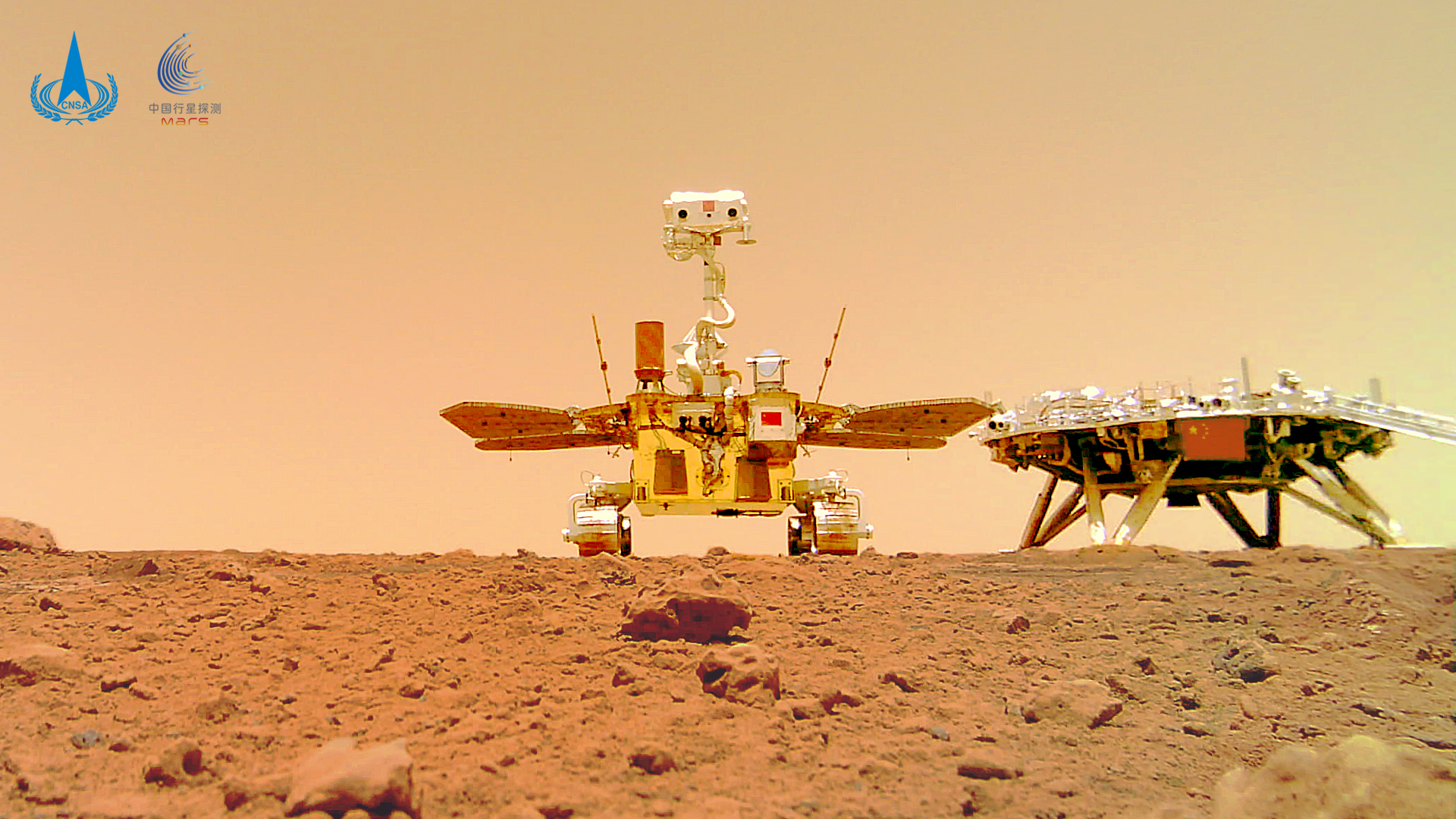Europe's Mars orbiter relays data from Chinese rover back to Earth

The European Space Agency's Mars Express collected data from China's Zhurong Mars rover and successfully sent it to Earth following a series of experimental communications tests.
The Zhurong rover on Mars was designed only to communicate with its companion orbiter, Tianwen 1; however, the rover has long outlived its planned mission and the orbiter is no longer able to do as much data relaying. So China and Europe decided to try an experiment: Send data from Zhurong to Mars Express to Earth. That's challenging, since the robots' communications equipment doesn't match. Zhurong can transmit at a frequency Mars Express can detect, but not vice versa, so Zhurong sends data without hearing back from the orbiter.
On Nov. 20, Mars Express passed 2,500 miles (4,000 kilometers) above Zhurong's location in Utopia Planitia, received a batch of data, then transmitted the data across 230 million miles (370 million km) of space to European Space Operations Center ground stations, which then forwarded the data to the Beijing Aerospace Flight Control Center.
Related: China's Mars rover Zhurong just snapped an epic self-portrait on the Red Planet (photos)
"Mars Express successfully received the signals sent by the rover, and our colleagues in the Zhurong team confirmed that all the data arrived on Earth in very good quality," Gerhard Billig, a systems engineer at the European Space Agency (ESA), said in a statement.
Mars rovers collect a wealth of science data down on the surface but don't carry large communications arrays. Insead, they rely on orbiters to relay their high volumes of data across the inner solar system to Earth.
Normally a rover and orbiter will exchange short messages to establish two-communications and transmit data. But, according to ESA, Mars Express transmits its "hello" signal using communication frequencies that are different from those the Chinese Zhurong Mars rover receives, making two-way communication impossible. However, Zhurong can transmit signals using a frequency that Mars Express can receive, so ESA carried out a first test of a one-way communication technique: communication "in the blind," where the sender can't be sure if their signal is being received.
Get the Space.com Newsletter
Breaking space news, the latest updates on rocket launches, skywatching events and more!
Zhurong, China's first Mars rover, landed on the Red Planet in May this year and has been exploring Utopia Planitia. With only a small antenna on the rover, its companion Tianwen 1 orbiter has been relaying Zhurong's science data to Earth. But with the start of Tianwen 1's own science mission in November, the opportunities for relaying the valuable information from Zhurong have been reduced. Instead, the orbiter is focused on mapping Mars.

Existing cooperation between ESA and the China National Space Administration (CNSA) opened the way for a series of five communications tests between Mars Express and Zhurong, all carried out in November. (ESA also provided ground station support for various moments during Tianwen 1 and Zhurong's journey to Mars.)
Mars Express received a signal during each of the five tests, but during four of these, the received data was corrupted, an ESA spokesperson told Space.com via email. During an investigation into the glitches, interference from another unit on Mars Express was deemed responsible.
The fourth test, on Nov. 20, yielded results, however, as the orbiter successfully collected 233 kilobytes of data and sent it on to Earth. The mission teams are now arranging additional tests. "We're looking forward to carrying out more tests in the future to continue to experiment and further improve this method of communicating between space missions," Billig said.
Teams will check when Mars Express will have visibility of the Zhurong rover and that the tests will be compatible with the orbiter’s science plan. The next test would examine different bit rates and overflight durations, ESA said.
"In principle, it would be possible for Mars Express to play a formal relay role for Zhurong in the future, but this would have to be agreed between the two space agencies," the ESA spokesperson noted to Space.com.
Mars Express has been in orbit around the Red Planet since December 2003. Its activities include discovering methane in the Martian atmosphere, mapping the composition of polar ice and tentatively detecting subsurface water beneath the south pole.
A China Lunar Exploration Project report on the communications test also revealed that Zhurong has covered a total of 4,255 feet (1,297 meters) in 196 Martian days, or sols, since landing on May 14.
Zhurong had already covered 4,111 feet (1,253 meters) by early November, suggesting that the rover has been spending time analyzing a sediment-filled trough with its science payloads rather than pushing south.
Follow us on Twitter @Spacedotcom and on Facebook.
Join our Space Forums to keep talking space on the latest missions, night sky and more! And if you have a news tip, correction or comment, let us know at: community@space.com.

Andrew is a freelance space journalist with a focus on reporting on China's rapidly growing space sector. He began writing for Space.com in 2019 and writes for SpaceNews, IEEE Spectrum, National Geographic, Sky & Telescope, New Scientist and others. Andrew first caught the space bug when, as a youngster, he saw Voyager images of other worlds in our solar system for the first time. Away from space, Andrew enjoys trail running in the forests of Finland. You can follow him on Twitter @AJ_FI.









